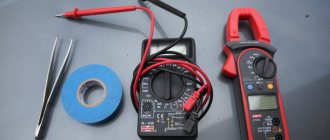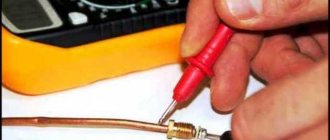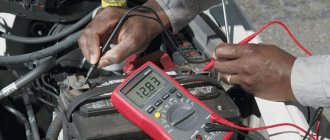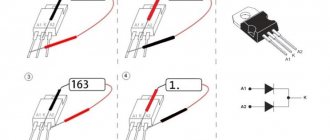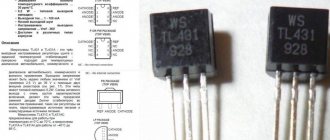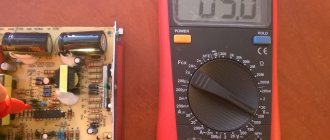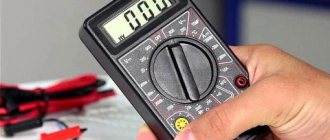Without a working battery, a modern car turns into a pile of iron, even if it is expensive and well packaged. You can check the performance of such an important part using a multimeter. The main thing is to know the features of its use in different situations. To do this, we will tell you how to test the battery with a multimeter.
From this material you will learn how to measure a battery with a multimeter in different ways: how to measure battery voltage with a multimeter, how to measure amperes, etc.
General information
A multimeter allows you to find out the real voltage of the battery, and the readings will be as accurate as possible. In turn, by the voltage you will understand whether the car battery is charged or needs power.
By the way, you can use a multimeter to find out the voltage of phone chargers. Video on how to check 12V with a multimeter using the example of such a power supply:
This meter also allows you to detect current leakage. At the same time, it is important to check for leaks not only on the body, but also in the on-board vehicle network.
In general, checking the battery with a multimeter is possible by:
- capacity;
- resistance;
- current or amperage;
- charge (voltage).
Thanks to this range of measurements, you can minimize the likelihood of rapid battery discharge and increase its service life. And if, for example, you know how to check the starting current of a battery with a multimeter, then you will understand why the engine does not start.
In this useful article we will tell you about the most important things. Let's start with how to measure a battery's charge with a multimeter.
What battery resistance can be considered normal?
The norm for the internal resistance of a car battery can be considered a value that does not deviate from the nameplate within 5%..10%. The same approach is true for other battery parameters - capacity, current output, etc. In fact, manufacturers rarely indicate the r value in the accompanying documentation and almost never on the nameplate. The normal value can be found out from statistics - measure the internal resistance of several batteries in a known good condition and fully charged. If measurements are carried out at the same load, an average value of r can be obtained, which can be taken as normal.
Battery with a cold cranking current of 500 amperes.
Another way is to calculate the parameter through the maximum current output. For example, if the manufacturer declares the maximum current supplied by a lead-acid battery as 500 amperes, then you can substitute the following values into the formula for the complete circuit:
- E=12.6 volts (open circuit voltage of a fully charged battery);
- R=0 (short circuit mode);
- I=500 A.
I=E/(R+r), hence r = E/IR = 12.6/500-0 = 0.025 Ohm = 25 mOhm. This value can be compared with the measured one, but it should be understood that the measurements must be carried out under exactly the same conditions as in the manufacturer’s laboratory, so an exact match should not be expected.
The internal resistance of a battery is a parameter that is more difficult to understand and provides less information than the same battery capacity. But knowing this characteristic will help you quickly assess the general condition of the battery and provide additional qualitative information. It must be clearly understood that the value of r nonlinearly depends on many parameters, including the state of charge of the battery, temperature, relative load level of the battery, etc. But the forecast of the battery condition based on internal resistance measurements is still reliable.
How to check battery charge with a multimeter
And immediately a useful video on how to check the battery with a multimeter:
This item also shows how to measure the voltage on the battery with a multimeter in a car. Essentially, battery voltage = battery charging.
How to check charging with a multimeter on a car:
- Disconnect the battery from the car and wait about five hours.
- Set the measuring device to the “voltage” (DC) mode, which is designed to check voltage.
- Select 20 volts. This is true if the battery voltage is not higher than this value. For ordinary lithium car batteries, 20 volts is enough.
- The wires connected to the turned on multimeter tester now need to be connected to the battery: red cable to positive, black to negative. If the wires are the same color, look at the markings. Perhaps they need to be connected to opposite charges. Be sure to read the instructions for use before using the multimeter! But there is a nice thing about how to measure battery charge with a multimeter: if you mix up the colors of the wires, the number will be correct, but there will be a “-” sign next to it.
Here is such a simple technology, how to check the battery charge with a multimeter on a car.
When the wires touch the battery, numbers appear on the display, which can be used to understand the state of charge:
- From 12, 6 or 12.7 - rest assured, everything is fine with the charge.
- If the value is worse, but does not fall below 12.1, the charge is about 50% or slightly higher. In this case, the battery can be charged.
- A reading between 11.6 and 12 indicates severe wasting. Time to worry a little and charge the battery to avoid problems.
- If the value is even lower, the matter is, as they say, “pipe.” If you continue to use the battery in this condition, it will break.
Here is a useful picture for checking the battery charge with a multimeter:
How to check the battery charge using a multimeter if the engine is turned on, and is it possible to do this?
If you have started the engine, then you can use a multimeter to analyze the functioning of the battery. But its functioning along with the generator will be shown, as well as the functionality of the voltage regulator. The process of how to measure the voltage with a multimeter on a car battery with the engine on is common, but the values differ. The numbers that are within the normal range are slightly higher, somewhere from 13 to 14. If other values appear during the measurements:
- Reduced ones indicate that there are problems with the charge. This may also indicate a malfunction in the generator operation, such that it is not able to fill the battery to the required level.
- If the values are higher, the battery is not fully charged, and the generator works harder to supply energy to the necessary car parts. Consider the situation. For example, in the cold the battery has lost its charge, then the generator will work at increased voltage to fill the battery. You can wait 15 minutes and take the measurement again.
Now you know how to check the charge of a car battery with a multimeter.
Video on how to check battery voltage with a multimeter on a car:
What you can check
A multimeter is a special device that allows you to measure voltage, current, resistance, temperature, etc. This is a common device that is widely used in various fields and fields of activity.
Almost every motorist who does at least minimal maintenance of his car should have such a device at his disposal.
Using a multimeter you can check:
Yes, in some cases, in addition to the multimeter itself, additional devices will be required. But finding them in your garage or buying them for little money will not be a problem.
Voltage
Let's first consider how to check the voltage in a battery with a multimeter, and what you need to do for this.
It’s not difficult to figure out how to check the charging of a battery with a multimeter yourself. It is enough to follow the instructions and also do not forget about safety precautions:
- First you need to assemble the device. Before checking the charging of your battery with a multimeter, switch it to the voltage measurement mode, that is, voltage. Because for some reason many people switch on amperes.
- If you have a rotary switch, you need to turn it to the measurement threshold position of up to 20 Volts. That is, just set the 20V mark. Since the battery produces up to 14.5 V (when the engine is running), a range of up to 20 V will be optimal.
- To measure the voltage of your battery, connect your multimeter to the battery terminals. The black wire goes to minus and the red wire to plus.
- Now record how many volts the device shows. Next, draw appropriate conclusions.
How to measure a car battery's capacity with a multimeter
How to check a battery with a multimeter to find out the capacity? Thanks to it, you can understand how much charge the battery provides over a certain period of time at a certain voltage. Capacity is indicated in Ah. You can measure it with a multimeter under load.
If you want to know how to test a battery with a multimeter under load, you can take two headlight bulbs. They are switched on in parallel. In our example, their total power is 110 W. We will supply a current of about 9 A through the light bulbs. Before starting the process, make sure that the battery is fully charged.
Instructions for checking the battery with a multimeter on a car:
- Connect the load and measuring device to the terminals. Select voltage measurement function.
- Note the time and wait until the voltage at the battery terminals drops to 10.3 V.
- Look at your watch and determine how long it took for the battery to lose its charge. Let in our example it be 7 hours.
- Calculate capacity. To do this, multiply the time (in hours) by the discharge current (in our case 9), that is, 7 * 9 = 63 Ah. Then we open the battery passport and see what capacity is indicated in it. For example, 65 Ah. As you can see, the difference is very small, which means everything is in order. If the resulting capacity is much lower than the rated capacity, the battery needs to be changed.
Remember that the battery cannot be completely discharged, so do not allow the voltage to drop below 10.3 V during the measurement. Lead batteries cannot be stored discharged, so after checking, immediately fully charge it, otherwise in a few days it will only be suitable for garbage.
This is how the battery is checked with a multimeter.
Checking the battery charge when measuring electrolyte density
This method of checking is quite useful before the onset of winter. A decrease in ambient temperature reduces the density of the electrolyte. Thus the charge also drops. Low density increases the risk that the car engine will not be able to start.
To check the charge of a car battery, you need a special device - a hydrometer. The sequence of actions is as follows:
- 6 caps of battery cans are unscrewed.
- The hydrometer is placed inside the jar. And you need to wait until it is completely filled with electrolyte.
- It is pulled out and over time the float will indicate the current readings.
If the car battery is in good condition, then during the cycle from full discharge to full charge, the range of changes in electrolyte density will be from 0.15-0.16 g/cm3.
Using a car at low negative temperatures with a discharged battery will lead to freezing and disintegration of the lead plates.
In the table you can see at what sub-zero temperature, depending on the density of the electrolyte, ice appears in the battery.
| g/cm3 | 1,10 | 1,11 | 1,12 | 1,13 | 1,14 | 1,15 | 1,16 | 1,17 | 1,18 | 1,19 | 1,20 | 1,21 | 1,22 | 1,23 | 1,24 | 1,25 | 1,28 |
| °C | -8 | -9 | -10 | -12 | -14 | -16 | -18 | -20 | -22 | -25 | -28 | -34 | -40 | -45 | -50 | -54 | -74 |
As you have already noticed, even a fully charged car battery will freeze at a temperature of -74 degrees, and with a capacity of 40% it will freeze at -25 degrees. And with a low charge, up to 10%, it will not be possible to start the engine even in mild frost.
How to measure current with a multimeter on a battery
This is a question like how to check the amperage of a battery with a multimeter. Load is definitely needed.
It is pointless and even dangerous to measure the current strength on the battery itself.
A headlight lamp can act as a load element. Remember that the load cannot be higher than 120 W.
How to measure battery current with a multimeter:
- Set the meter switch to measure the required current.
- Select the Ampere limit (maximum is better first).
- Connect the positive probe to the battery positive.
- Connect a lamp to the minus gap. That is, the minus from the multimeter should be directed to the lamp, from which the circuit is closed on the battery minus.
- Check the values on the multimeter. Compare them with those indicated on the battery case.
Make sure that the contact of the probe with the battery lasts no longer than two seconds!
We learned how to use a multimeter to test the amps of a car battery. The main thing is to do everything quickly and accurately. And you can do this because you know how to check the current strength on a battery with a multimeter.
The video explains in detail how to check the battery current with a multimeter:
How to test a car battery with a multimeter for internal resistance
It is also important to know how to measure the internal resistance of a car battery with a multimeter. This also requires a load. Let's take a 60 W halogen light bulb. The current consumption will be 5 A. If the amperage is 100 A, then the voltage loss should not exceed 1 V. This means that with our value of 5 A, the voltage is about 0.05 V.
How to properly check a battery with a multimeter:
- Connect the lamp to the battery.
- Wait until the lamp starts to shine.
- When this happens, look at the voltage value at the battery terminals, that is, you need to use a multimeter.
- Record measurements.
- Turn off the lamp.
- Check the voltage values at the terminals again.
Now you just need to determine the difference between the two values. If it is no more than 0.05 V, everything is fine with the battery, that is, the internal resistance is correct. If the difference is large, it means the battery is very worn out, try to replace it as soon as possible.
Now you have the answer to the question: is it possible to test the battery for internal resistance with a multimeter?
If you don’t want to figure out on your own how to measure amperes in a battery with a multimeter, how to measure the battery charge, how to check a car battery for other parameters with a multimeter, don’t worry. There will always be specialists who, for money or out of friendship, will carry out all the necessary measurements of the battery with a multimeter.
External inspection of the battery
You met the seller and have already walked around the car, seeing how clean and beautiful it is. It's time to look under the hood, you lift the lid and see the usual contents of the engine compartment, the engine and numerous systems that keep the car running.
In most cases, here, in the engine compartment, there is also a battery - a rectangular box with electrolyte inside, to which two wires are connected - positive and negative. These wires go to the distribution block, and from this massive electrolytic “battery” the entire machine and all its systems are powered with electricity.
Even if you don’t understand anything about cars and went for an independent inspection rather as part of a formality, you can still determine by the appearance of the battery what condition it is in.
During an external inspection, attention should be paid mostly to the integrity of the elements, and whether the battery itself and contacts are clean. There are a number of external factors, the presence of which immediately indicates the need to replace or at least clean the battery.
- Dirt on contacts. In order for the battery to work, both contacts connected to it by wiring must be clean. If the contacts are dirty, this indicates that the battery is not new, and dirt will interfere with the correct operation of the contacts.
- Oxidation of the terminals - foreign deposits can be seen on the battery terminals with the naked eye - this is oxidation, which in most cases is associated with electrolyte leakage. Electrolyte is an acid that is found inside the battery. If it spills and gets on the contacts, it can lead to poor battery performance and a reduction in the contact area.
- Cracks on the case - the battery itself should be intact. The plastic box containing the electrolyte must not be damaged. This is also clearly visible without additional equipment and in good lighting.
- Dirt, dust, electrolyte leaks - all this is removed with a rag, and the car should not be allowed to drive with a dirty battery, since the conductive deposit will contribute to its rapid discharge and deterioration of performance.
In addition to the external inspection, you can start the car engine. A cold start will be especially indicative if the engine has not been started for a long time and it is cold outside. If the car starts easily, the battery is in order, but if it does not start or starts with difficulty, the headlights shine dimly, and the instrument panel is also not brightly lit, then the battery should be changed. Or, at least, check it with instruments, which we will discuss below.
How to measure battery leakage current with a multimeter
Any battery has leakage current. It is important to ensure that the value does not exceed approximately 80 mA. The fact is that energy, at least a little, is consumed even with all consumer parts of the car turned off. It is also worth considering that energy supports the functioning of the alarm system.
If the leak is too large, then diagnostics are required.
How to measure a battery with a multimeter for current leakage:
- Turn off the engine.
- Turn off the ignition.
- Wait 15 minutes.
- Turn off absolutely all consumers.
- Remove the negative from the battery.
- Set the multimeter to DC current test mode.
- Select range up to 10 A.
- Connect the positive cable of the multimeter to the positive cable of the battery.
- Connect the negative battery to the removed negative terminal.
- Record the indicators.
If there is no leak, you will see zeros. If there is a leak, you will understand from the values how big it is. You can find out where the problem lies: you need to turn off and turn on the fuses one by one.
It’s so easy to figure out how to measure a battery with a multimeter on a car for current leakage.
Now you know how to measure amperes on a battery with a multimeter, how to check battery charging with a multimeter, how to test a battery with a load with a multimeter, and much more. And for such testing you will need a regular multimeter, and you do not need a load fork.
We wish you to measure the battery with a multimeter correctly and safely!
Checking the battery with a load fork
The load fork is a very precise tool, but is rarely used in “manual” use, as it is used mainly in service stations. The beauty of this method of verification is that thanks to it an absolutely accurate result will be known.
The load plug works in a similar way to a multimeter: it is also connected to the battery terminals, but produces a short circuit current. As we already said, without load the indicator should approach 13 volts. The load fork imitates the operation of a starter, which is why the voltage “sags” at the moment of use.
The drop should be no more than 9 volts. Otherwise, it will mean that the battery is very discharged. After removing the load, the indicator again “rolls back” to its original value. If under load the voltage “sags” to 5 or even 3 volts, this means that the battery will not be able to start the car engine.
It is recommended to think about changing the battery even if the voltage when using the load plug drops below 9 volts.
An extremely important note: the load plug supplies approximately 200 amps of voltage to the battery and is not recommended for use in low temperatures. The ideal conditions for “field” use of this device is a temperature of +20-25 degrees Celsius.
If you apply voltage to a cold battery, there is a risk of severely discharging it.
